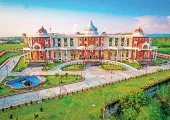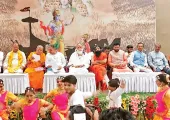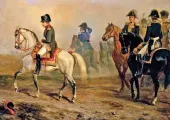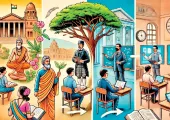India's Tradition Of Victory
On

Pro. Rameshwar Mishra Pankaj
The Mahabharata war took place 5200 years ago, whose complete history is accessible. Its historian Shri Ved Vyas was alive at that time and he has described the war as the events he saw with his eyes. Therefore, it is a completely certified record due to contemporary evidence. In the Mahabharata, under the Bhishma Parva, in the Jambu Khand Nirmanpan Parva, in the ninth chapter, about two hundred and fifty districts of India are mentioned. In which Gandhara, Utsav Sanket, Trigarta, China, Uttar Mlechha, Upper Mlechha, Hun, Parsik, Bahlik, Pahlav, Yavan, Dard etc. districts are included. The 20th chapter of Bhishma Parva describes the armies of both the sides, out of which the kings and soldiers of the countries like Shaka, Pahlava (Pahlavi), Yavana etc. are described under the control of Kripacharya on the left side of the Kaurava army. According to Manusmriti, the 12 Kshatriya castes of India which became extinct due to lack of Yagyadi rituals, include Yavan, Shaka, Dard, Bahlika, Pahlava, Kirat, Parad, Dravina etc. In this way, according to all the history books, theology and Puranas, the Yavan region has been a state of India. The border of India which was till recently till Gandhara and Parsik province, is in the neighborhood of Yavana province. In fact, Yavan province was never a part of Europe for thousands of years. It was a part of Bharatvarsha and Jambudweep.
Similarly, in Valmiki Ramayana also there is description of Bahlikas and Yavanas etc. Thus it is Indian territory only. Therefore, wars between each other within the ancient Indian territory cannot be called aggression. They are mutual wars, which were mainly for the achievement of valor.
There is no evidence of Alexander coming to India
Europeans tell the first invasion of Alexander, but there is no description of Alexander's invasion of India in the history of Macedonia itself. The original copy of Magasthenes' Indica is not available anywhere, however, several hundred years later India has been called invincible even in the description written by the author. It is mentioned in Indica that there was no invasion of India since 4000 years before Christ. But those facts of Indica were never made a part of public discourse. For the first time in the 18th century AD, William Jones called Alexander a unique warrior and talked about his victory over India, but no contemporary evidence was presented.
No Gajna, no Gor: No end to gossip
The second invasion is said to be of Mahmud of Ghazna and Muhammad of Ghor, but no contemporary evidence is available for them either. In fact, Elliot and Dowson had created these facts in the 19th century AD, declaring that it is necessary to present this fact to remove the inferiority complex in front of Hindus in the company's employees. That India was invaded and ruled by Muslims and committed unspeakable atrocities. He also announced that although its evidence is not being found within India, but we have to find or create these evidence ourselves. In this way, he created stories of Mahmud of Ghazna and Muhammad of Ghor and told it as history even though there is no evidence of their time. While there is no contemporary evidence of the time of an event anywhere in the world, it is not claimed as authentic evidence.
Gossip of company employees
It is necessary to know about Elliott and Dowson. Henry Elliot was an employee of the East India Company who was working in Bengal. The biggest trouble they faced was that the Bengali Hindus praise their kings and queens on the coming days and continue to despise the English employees of the company even while working in the company, because they consider them as employees from a very minor state. Those British employees complained to Elliot that these Bengali Hindus humiliate us by telling us the glory of their kings and queens throughout the day. On this, Eliot thought that we should write such a book in which it should be told that Hindus have been beaten by Muslims and Muslims have done great atrocities on them, so they should support us.
Elliot told the familiar Muslims of Bengal and also got the duggi beaten all around that whoever brings something to us regarding the Muslim state, he will be rewarded. No one brought anything for a long time. Then again by increasing the amount of the prize, he was beaten. Then after many days a Muslim scribe came with a book. Investigation revealed that it was a forged book and only nonsense was written in it. There was no information about the Muslim state. Then Eliot decided that he would search in Iran, Afghanistan etc. that there might be such a book.
He has also written that even if we get some fragments, we will be able to create a glorious Muslim history on the basis of them. After wandering for a few years, he found a book written in Persian language of 1186 AD. Whose title was 'Tarjuma-e-Yamini'. However, this book was not available anywhere in India. No one has even seen a copy of it in India. Of. Its English translation by Reynolds was published from London in 1858 AD. That's what's available. After this, Karamat Ali of Delhi also wrote a book on the same lines i.e. on the lines of Reynolds' translation with the same name i.e. Tarjumaye Yamini in the 20th century AD. This is explained in the second article in the second volume of Elliott & Dowson's eight-volume book. It is clear from this that in fact even the alleged first book is said to be 150 years after the death of Mahmud Ghaznavi and that book was also not found anywhere else. Eliot's translation was first printed in the late 19th century AD.
The forgery of the then Christain priests is famous
The priests had a notoriety at that time for forging compositions. They considered this forgery as a sacred work, because it was their helps in spreading the light of Lord Jesus. So all the symptoms are that it is a forgery, but along with forgery, its time is 150 years after Mahmud of Ghaznavi. is not contemporary. Hence not authentic. Along with this, it is a historical fact that Ghazna was a town only. It never became a big city. There could not have been any such army as is described. Nor is there likely to be any space and resources to hold that many millions of people and for food and toilet etc. The goods that are said to have been looted and taken away on camels, it is never possible to carry that much goods through those difficult hilly roads. Some people have even talked about heavy doors and golden idols etc. No camel can climb and descend the high mountains again and again carrying that much burden. He will die. So it is false in every way, but more importantly, Ghazni was a town in the kingdom of Maharaja Jaipal. Hence it was a part of Bharatvarsha only. That's why it is a ridiculous lie to present Ghazni as the capital of a foreign country. Ghajini was completely Indian. While Mahmud of Ghazni and Muhammad of Ghori (Ghuri), both are completely Indian. They are heretics, not foreigners. That's why it was the purpose of the British to create unnecessary defamation through gossip and lies, but what is the purpose of such lies and gossip in independent India?
Alberuni has not written any victory story of Ghori
Similarly, no contemporary evidence is available about Muhammad Ghori. Alberuni, who is said to be his source, has not written a single word about Ghori. Because he was sent by his teacher to understand and bring the knowledge of India in writing. Were. Baruni is a great devotee of India and is fascinated by Indian knowledge. He considers his life blessed in taking the knowledge of India and spreading it in his area. Edward Sachau, while translating the Somnath temple at the place where he praised it, has mentioned the sudden destruction of the Somnath temple in the 20th century AD on his behalf. This is the mischief of the translator. The original author, Abu Rayhan Muhammad ibn Ahmad al-Biruni, has not written a single word anywhere about the destruction of Somnath. Not only this, he has not written a single word on any of Muhammad Ghori's victory journey or war etc. and he did not even come to India with Ghori. Hence the whole story of Ghuri or Ghori was told by the Firangis in the second half of the 19th century and . Composed in the first half of the 20th century. Thus Ghajini and Ghori all the stories are gossip and it is a crime to teach them as history in independent India. No one considered the need to investigate these stories of Ghazni and Ghori during the British Indian period because Indians could not imagine such lies in the name of history. There has been a very ancient and vast tradition of learning here. That's why Indians cannot imagine that all writing in Europe and all historiography is also agenda based political propaganda and Euro-American writers never hesitated in doing this kind of blatant false propaganda till the end of 20th century. Here and there the respect of education has increased over the years, but even now they do not hesitate for a moment to lie and do propaganda in the interest of their country or their religion. There is abundant evidence of this.
Qasim was a minor stray boy
There is a third big lie about Qasim. Muhammad ibn al-Qasim is said to have conquered Sindh in the early 8th century AD. This is such a big bundle of lies that the person who mentions it looks very pathetic with intelligence. The birth of this boy is said to be on the last day of 695 AD or the first day of 696 AD. He died in 715 AD. That is, he died at the age of 19 and a half years. It is now said that at the age of 17, he plundered the glorious Brahmin kingdom of Sindh. Its source is attributed to the author of the book, Al Baladhari, who himself lived in the second half of the 9th century AD. That is, 200 years after the death of Qasim. Then there is a dispute on whether that Baladhari sir's book was in Arabic or in Persian. It is not known why these Firangis did not print many copies of his manuscript. For the first time his translation was printed from Leiden in 1870 AD and from Cairo in 1905 AD. Baladhari's book 'Fateh al-Baldan' is mainly a story of the conquests of the Turks, in which a few lines are about the loot of a Qasim in Sindh. Even if it is considered to be authentic, then there is only a slight mention of it in it. Cartoons depicting this 17-year-old boy as a ferocious monster and ending the great Brahmin Shahi as a ferocious Muslim general have been made in England and India in the 20th century AD. At first sight it sounds ridiculous. On the other hand Elliot and Dowson themselves and many other European historians have written that till the middle of the 15th century AD, Hindus were ruling in Sindh. Everyone is unanimous on this. Even then India is full of traitors who sing the praises of Chhokra Kasim's victory in the 8th century AD.
It is even forgotten that Khorasan belonged to India for centuries. The state was Its rulers were Bahrik Kshatriyas. He converted from Buddhist to Muslim in the 10th century AD. Babur etc all belonged to this Khorasan.
Declaring the Jagirdars of Delhi as the Rulers of India is sinful
More important thing is that if ever the jagir of Delhi is occupied by a Jagirdar who converted from Hindu to Muslim, then it is a terrible lie to call him the emperor of India. In fact, for the first time in 1912 AD, the British decided to make Delhi the capital due to the fear of revolutionaries, before that they had made Kolkata their capital and in fact only in 1932 AD Delhi became the capital of the British Indian territory. Prior to that, Ayodhya, Hastinapur, Patliputra, Purushpur (Peshawar), Kannauj, Thaneshwar, Nashik, Ujjayini etc. have been the capital of India for thousands of years. Indraprastha was a separate state, at that time the capital of India was Hastinapur. Therefore, it is natural for the Muslim Jagirdar of Delhi Jagir to be called the king of India by his sycophants, but it is a crime to call him the ruler of India while teaching the history of the whole of India. The kings of Panna, Charkhari, Hamirpur, Banda, Singrauli, Sidhi etc. are also called Bhupati and Prithvipati in their respective kingdoms, but those who call them the rulers of the whole earth in history books would be laughable. Equally laughable are the people who call Muslims the rulers of India.
The truth is quite the opposite. Syria, Turkey and the entire Parsik Janapada (of which Iran and Iraq are part and which has also been a part of Arabia) have been under Hindu and Buddhist influence till the 15th century AD. The first epic written in Turkish language in praise of Prophet Muhammad dates back to the 15th century AD. Before that only poems and texts of Buddhist and Hindu philosophy were written there. Singhdwaras have been found in Hattussh, located 95 miles east of Turkey's capital Ankara, which are the symbols of the Hindu kingdom there. The Buddhist and Zoroastrian influence in Syria lasted till the 18th century AD and was eradicated by the French. India's Panis have been ruling in Syria for centuries. In BC, on the banks of Tijla river, there was a city called Bhagadatta, which was later called Baghdad. There was worship of Surya, Mitra, Varuna and Agni deities, evidences have been found for this. Pictures of Lord Shiva and Simhavahini Jagdamba Durga and Skandaswami Kartikeya have also been found from Syria to Kriti Rashtra and coins have also been found. That's why fictional history should not be taught.
-to continue
लेखक
Related Posts
Latest News
01 Dec 2024 18:59:48
योग प्रज्ञा योग - योग जीवन का प्रयोजन, उपयोगिता, उपलब्धि, साधन-साधना-साध्य, सिद्धान्त, कत्र्तव्य, मंतव्य, गंतव्य, लक्ष्य, संकल्प, सिद्धि, कर्म धर्म,...








.jpg)




